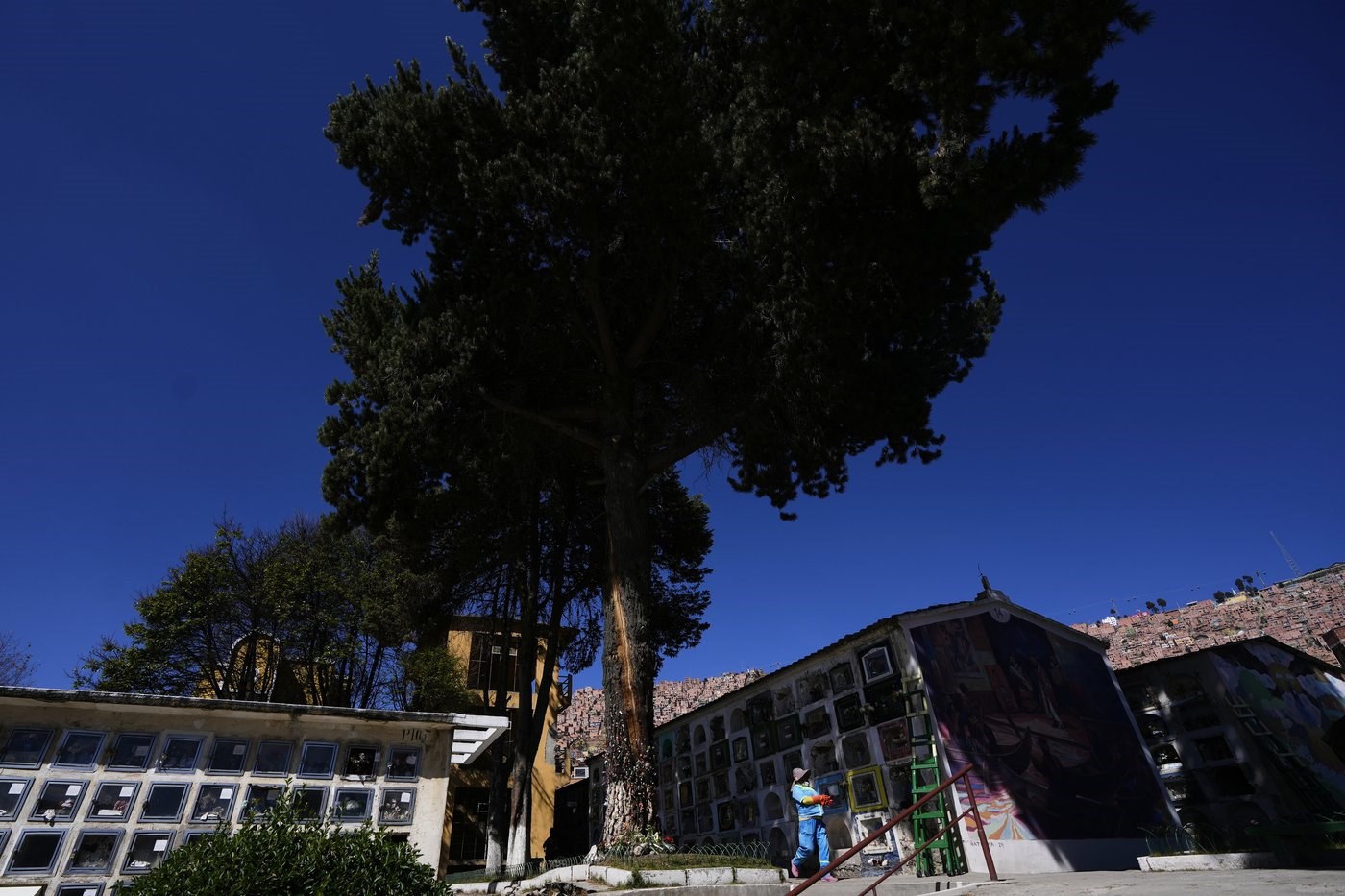
A tree that was struck by lightning years ago, and has since been considered sacred, rises above the General Cemetery in La Paz, Bolivia, Sunday, Aug. 31, 2025. (AP Photo/Juan Karita)
Republished September 02, 2025 - 4:44 PM
Original Publication Date September 02, 2025 - 12:31 PM
LA PAZ, Bolivia (AP) — Struck by lightning during a roaring thunderstorm 10 years ago, an ancient pine tree in Bolivia's capital of La Paz is thriving.
Known as the “miracle tree,” this giant conifer now draws devotees from across the country to La Paz’s largest public cemetery, founded two centuries ago on a pre-Columbian burial plot. Pilgrims stream through the alleys bearing offerings — coins, flowers, sweets, handwritten disclosures of secret wishes — to stuff into bark crevices.
On a chilly afternoon last week during the throes of an election season, pilgrims made their way to the miracle tree through the winding alleys of the cemetery packed with over 200,000 graves, many belonging to decorated soldiers and dignitaries.
As Bolivia is now heralding the end of almost two decades of leftist rule under its first Indigenous president, Evo Morales, and his successor, even electoral drama and economic collapse seemed eclipsed by other concerns for devotees of the miracle tree.
“People ask for love, work, health, children, even to bring back their lost pet,” explained Javier Cordero, who leads funeral prayers at the cemetery. “If the person comes with a lot of faith, the tree will fulfill their wishes.”
Some of the devotees were young, having recently discovered the story of the tree on TikTok.
Others were regulars, older Bolivians long convinced of the tree’s sacred powers, like 79-year-old prayer leader Ricardo Quispe, who was taking refuge beneath the tree’s sheltering limbs when lightning struck on that stormy afternoon a decade ago. He claims the lightning bolt also gave him psychic powers.
Far from pulverizing the tree, the rogue bolt of lightning left a scar on its trunk that now oozes aromatic resin. The towering tree in the La Paz cemetery now appears healthier than ever.
A study probing how certain trees may benefit from lightning strikes — published earlier this year in the journal New Phytologist — offers some scientific basis for this tree’s surprising transformation. But long before such forest ecology studies, Indigenous Aymara shamans in Bolivia believed lightning strikes bestowed divine powers upon their survivors, whether people or trees.
Such rites abound in this Andean nation, where ancient pre-Hispanic beliefs underlay the Catholicism brought by Spanish colonizers.
Yatiris, specialists in divining good luck and performing energy cleansings, fill the streets of La Paz and the neighboring Aymara city of El Alto, selling their services to anyone in need of blessings — from women trying to get pregnant to farmers hoping for healthy crops.
August, a time of transition from winter to spring in the regional agricultural calendar, is an especially busy time for yatiris in Bolivia, Latin America’s only Indigenous-majority country.
Over the course of the month, Bolivians make offerings to Pachamama (Mother Earth), often hiring shamans to perform rituals in their homes and offices and or making pilgrimages to feed the hungry earth and mountain deities at sacred sites and cemeteries like the one in La Paz.
“I know people who have been healed from illnesses, they are the most devout,” Cordero said, touching the trunk of the miracle tree with a copper wire to demonstrate its special energetic charge. Within moments, the wire began to rotate in response.
“The lightning transmits the vital energy of the cosmos,” he said.
The belief in the tree's powers keeps many of its worshippers coming back.
Tania Arce, 60, approached the miracle tree with her arms full of tantalizing chocolates and flowers.
“He likes sweets,” she said, speaking about the tree as if it were her son. “He fulfilled the favor I asked of him, but I haven’t stopped visiting.”
____
Follow AP’s coverage of Latin America and the Caribbean at https://apnews.com/hub/latin-america
News from © The Associated Press, 2025